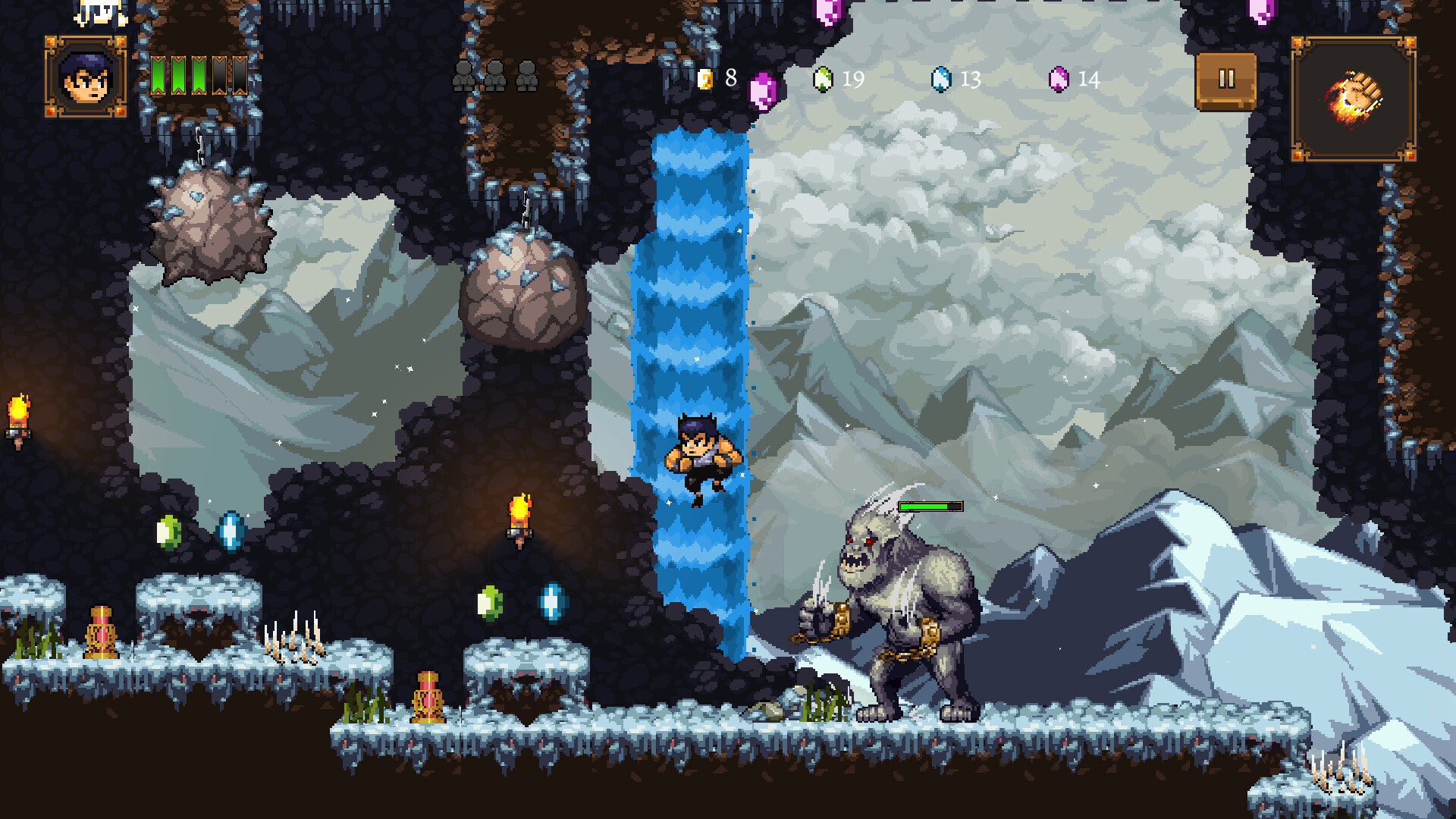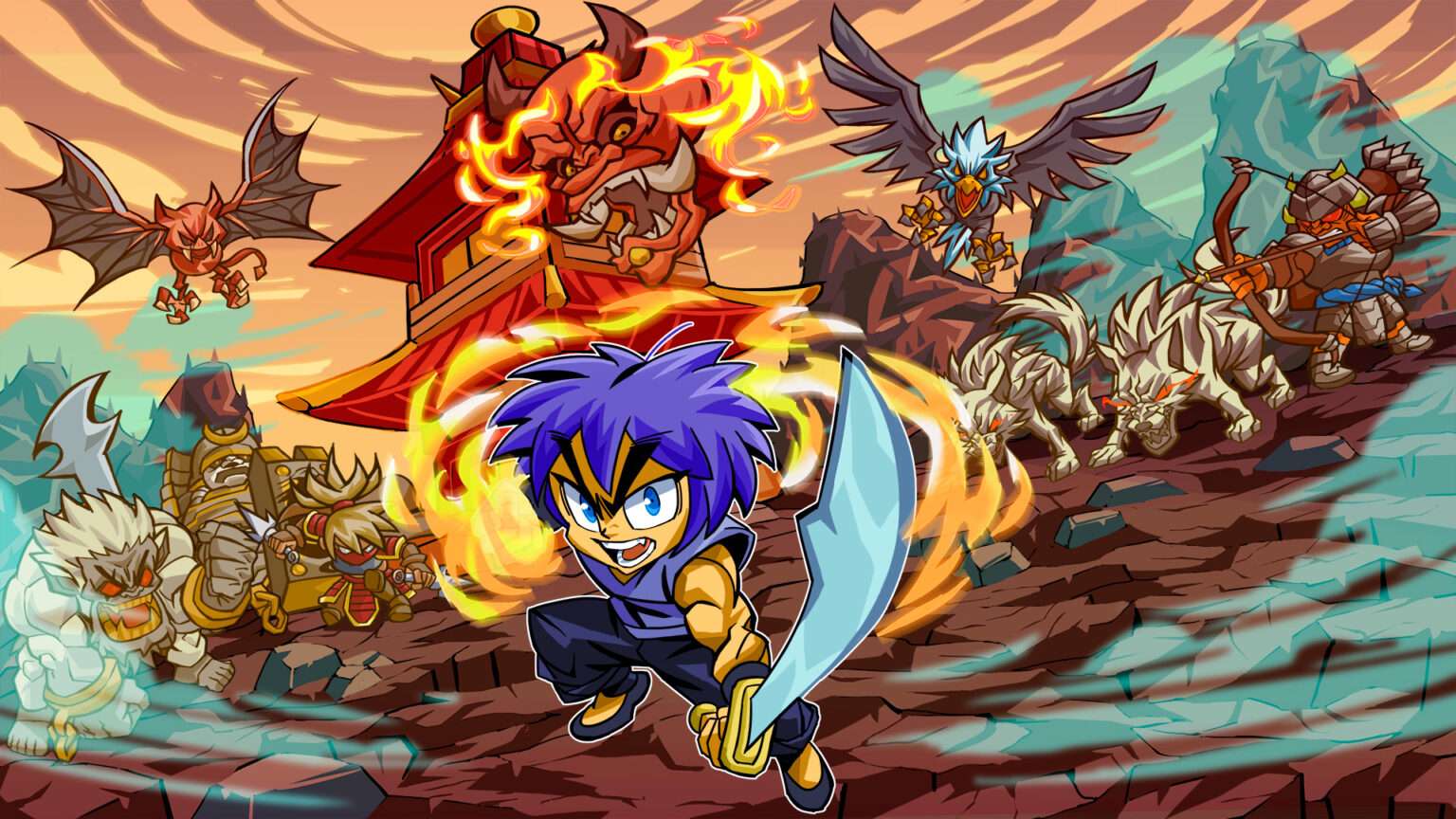We have played Shadow of the Orient for this review on Xbox Series X. The game is also available for PC, Playstation 5 and Nintendo Switch. The price all platforms is €/$ 9,99.
After some time as a mobile exclusive, Shadow of the Orient has made its way to consoles. It’s the debut title from SpaceLab Games, led by Leo Nanfara, and promises a Ninja Gaiden-style 2D platformer with 15 levels spread across three acts. It blends melee and ranged combat with challenging platforming, all set in the mystical Far East.
Lone Warrior
You play as Xiaolang, a mystical warrior who’s harnessed elemental powers to take on the Shadow Clan – a group of bandits terrorizing the region and kidnapping children left and right. It’s up to you to stop them, rescue the kids and restore peace to the land.
Modern-Day Platformer
For a modern 2D platformer, Shadow of the Orient keeps things pretty straightforward. There aren’t any standout mechanics that really set it apart gameplay-wise but that feels like a deliberate choice. Nanfara clearly leans into a more traditional style, channeling the spirit of classic 16-bit titles like Skyblazer on the SNES. The publisher likes to compare it to Ninja Gaiden, which I sort of get but while Ninja Gaiden strikes a balance between hit-and-run side-scrolling action and vertical platforming, Shadow of the Orient leans much more into the platforming side of things.
Visually, the Skyblazer comparison is actually fairly spot-on, though maybe a bit obscure. For those who know that game, Shadow of the Orient rocks a similar 16-bit color palette and rich parallax scrolling backgrounds. The game features three main areas that, while not wildly different, each feel distinct enough. Xiaolang has serious Jackie Chan vibes, somewhere between the Yie Ar Kung-Fu doppelgänger and the actual Jackie from his licensed PS1 game. The enemies look great too and they mostly fit right in with the game’s East Asian historical and folkloric atmosphere.
Left to right
While the game features a good amount of verticality, the levels usually follow a fairly linear left-to-right path. Straying from the obvious route usually leads to extra finds. This could be either treasure chests or kidnapped kids. Each level has four chests and three kids to discover, unlocked by hitting switches or finding keys which can usually be found close by. Since the rewards are mostly just more gems or the occasional heart; there’s not always a strong reason to take the risk. If I had full health, sure, I’d go for it, but more often, if I was already limping I’d just play it safe.

Enemies also drop coins, gems and the occasional power-up. Bigger enemies usually guard ornate vases that drop better loot. Either the enemy or the vase will typically cough up something useful.
Power-ups
Power-ups are somewhat random drops from enemies or chests and include protective fire rings, fireballs, and throwing knives. They’re super helpful – especially since they tend to show up just before tougher sections. Each level also has two or three checkpoints which is great, because you will die. A lot.
The problem is, your character’s only default attack is a basic short-range fire punch. That’s fine, except that most enemies attack so fast and so hard it’s nearly impossible to avoid damage. Birds and giant bats charge at you like heat-seeking missiles and the samurai enemies move so quickly that your sluggish melee attacks feel underwhelming in comparison. You can occasionally stun them but timing it right is frustrating and often feels unfair. Combat overall just feels clunky, cheap and unreliable. It gets worse as you progress and by chapter three, surviving from one checkpoint to the next became my main goal.
The unadvertised shop
Then I discovered, completely by accident, that there’s a shop in the main menu offering a bunch of ranged weapons and power-ups. I had no idea this was a thing. It’s never mentioned during gameplay, which is wild. To be fair, I played a pre-launch Spanish version, so maybe I missed a clue somewhere. Still, a hint or prompt to visit the shop would’ve made a huge difference. I assumed it was just for unlocking artwork or music.

Once I loaded up on gear from the shop, the game suddenly opened up a bit and the difficulty became more manageable. That said, the weapons have their own issues. There are some hit detection and timing quirks that make combat still feel a bit off. The bo staff for instance, has a hard time connecting with airborne enemies. Yes, the enemy type that is Xiaolang Achilles heel to begin with. It’s like the game is trying to make things harder in superficial ways, which is annoying but not quite rage-quit level.
Platforming versus combat
The platforming on the other hand, feels spot-on. Xiaolang can double jump and wall jump right from the start and it doesn’t take long to get the hang of it. The controls are tight and responsive — I had far fewer issues dodging projectiles or navigating around enemies than I did trying to take them down with basic hand-to-hand combat. Exploring the large levels is genuinely fun and handling obstacles or leaping across narrow platforms (sometimes lined with spikes) strikes a good balance between challenging and fair, without ever tipping into frustration.
Shadow of the Orient absolutely nails the look and feel - especially the pixel art and overall presentation. But whether it’s down to poor balance or just an intentional difficulty spike, the combat is often more hassle than it's worth. It stops you from settling into a rhythm, which is a real shame because the platforming is genuinely great. The fact that the shop is tucked away without a single in-game hint is baffling. It took me three hours to even realize it was there. Still, at its best, Shadow of the Orient is fun. At its most frustrating, you're scraping by, surviving on the skin of your teeth.
The Good
- Great looking pixel art
- fun and challenging platforming, with quite a bit of variation
- Well priced at €/$9,99
- Additional challenge levels available
The Bad
- A bit short, with 15 levels based on today's standards
- Flawed melee combat
- Item shop should've been integrated much better


